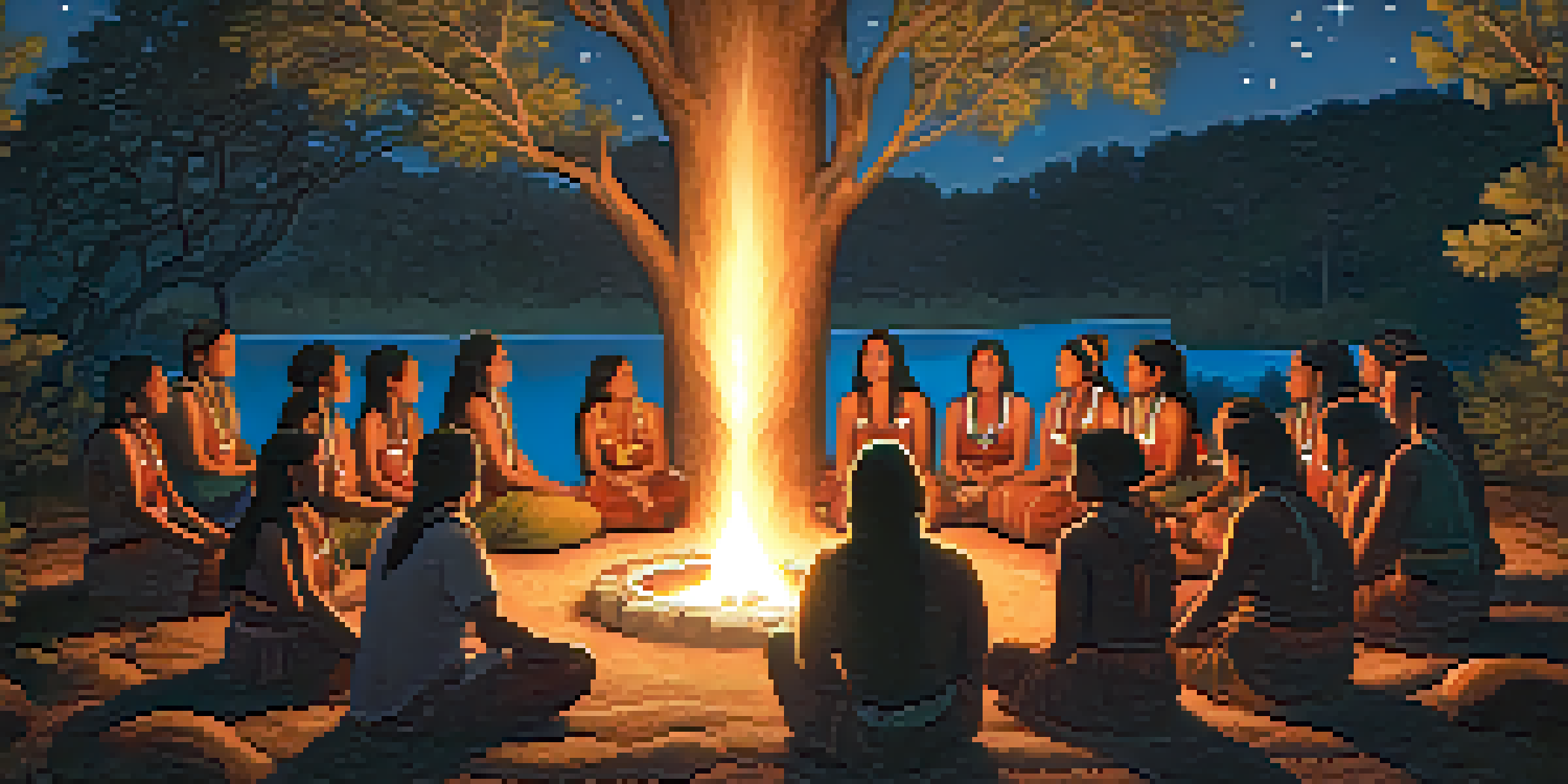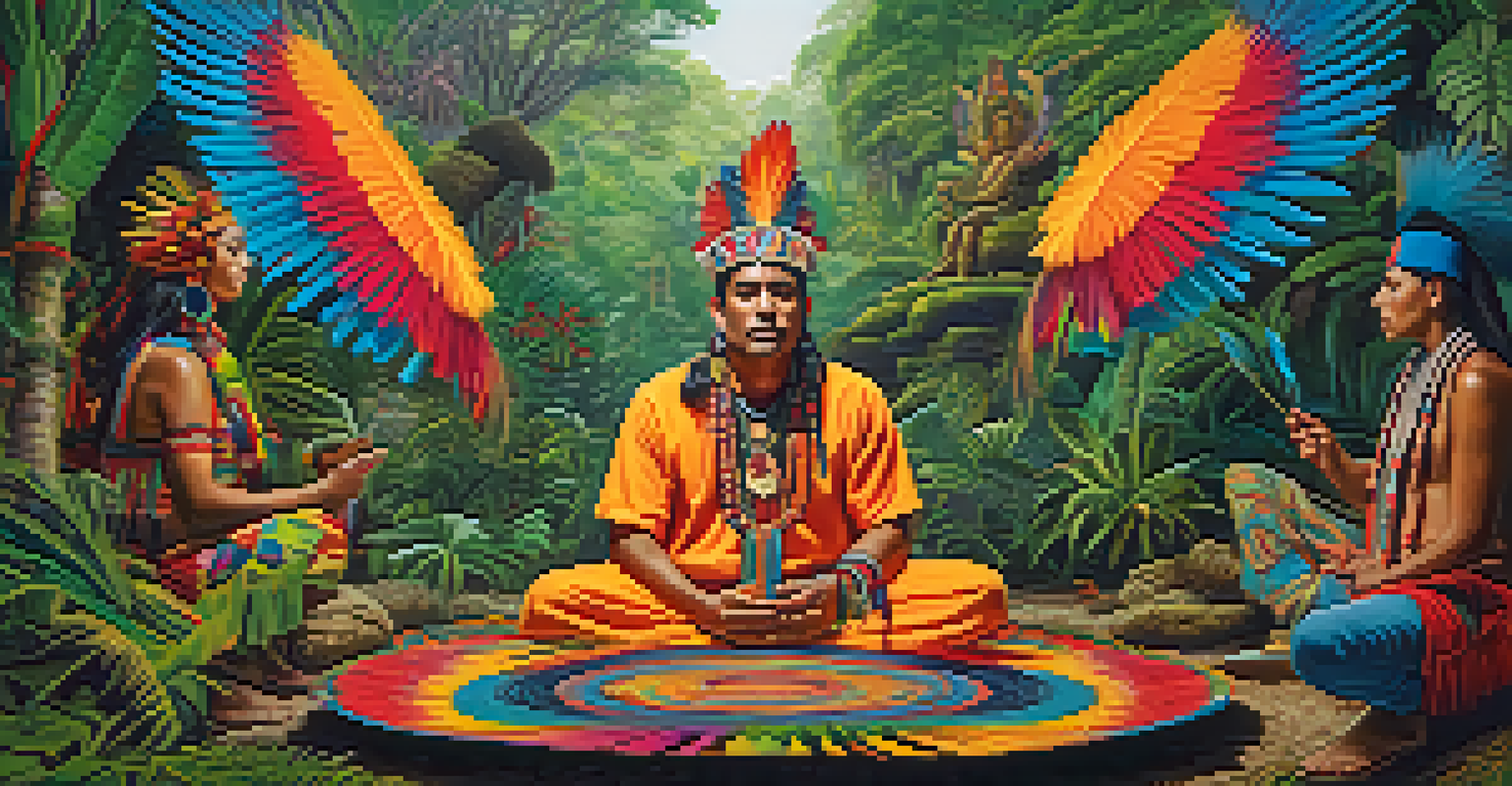Psychedelics in Ancient Cultures: A Journey Through Time

Introduction: The Fascination with Psychedelics
Psychedelics have long captured human imagination, often seen as gateways to spiritual experiences or enhanced creativity. Ancient cultures utilized these substances in rituals, seeking deeper connections with the divine or to unlock hidden knowledge. Understanding their historical context allows us to appreciate the profound impact these substances had on societies throughout time.
Psychedelics are not a panacea, but they can be a powerful tool for understanding the mind and exploring the depths of consciousness.
From the Aztecs with their sacred mushrooms to the shamans of Siberia using fly agaric mushrooms, the use of psychedelics transcended geographical boundaries. While modern society often views these substances through a lens of skepticism or fear, ancient peoples celebrated them for their transformative potential. This article will take you on a journey through various cultures and their unique relationships with psychedelics.
As we delve into the past, we’ll explore how these ancient practices resonate with contemporary discussions about psychedelics and their therapeutic benefits. This exploration not only sheds light on ancient wisdom but also invites a reevaluation of how we understand the role of psychedelics in our lives today.
Psychedelics in Indigenous Cultures: A Spiritual Connection
Many Indigenous cultures have used psychedelics as integral parts of their spiritual practices. For example, the use of peyote by Native American tribes highlights how these substances facilitate communication with the spiritual realm. Ceremonies often involve collective experiences that strengthen community ties and provide guidance from ancestral spirits.

In Amazonian tribes, ayahuasca serves a similar purpose, with shamans leading ceremonies that invoke healing and insight. These rituals emphasize the collective experience, creating a bond among participants that reinforces cultural identity and shared beliefs. Through these practices, psychedelics become more than just substances; they are tools for connection and understanding.
Psychedelics and Spirituality
Many ancient cultures used psychedelics as sacred tools for spiritual connection and communal experiences.
The respect and reverence shown towards these substances reveal a profound understanding of their potential risks and benefits. This perspective offers valuable lessons for modern society as we navigate the complexities of psychedelic use in therapeutic contexts today.
The Role of Psychedelics in Ancient Greek Mysteries
In ancient Greece, the Eleusinian Mysteries were a series of rituals that incorporated a mysterious drink called kykeon, believed to contain psychedelic ingredients. Participants sought enlightenment and deeper understanding of life and death through these secretive ceremonies. This practice highlights the cultural significance of psychedelics in exploring existential questions.
The use of psychedelics can be a profound and transformative experience, connecting us to the deep mysteries of existence.
The initiation into the Eleusinian Mysteries was a rite of passage, often described as life-changing. It provided a communal space where individuals could confront their fears and gain insights into the nature of existence. This transformative experience suggests that psychedelics played a key role in shaping philosophical thought in ancient Greece.
The mysteries remain largely enigmatic, but their influence on Western philosophy and spirituality is undeniable. By examining these practices, we can gain insight into how psychedelics have historically been intertwined with humanity's quest for meaning.
Psychedelics in Mesoamerican Civilizations
Mesoamerican cultures, such as the Aztecs and Mayans, utilized psychedelics like psilocybin mushrooms and peyote in their rituals. These substances were not merely recreational; they were seen as sacred tools for divination, healing, and connecting with deities. The famous Aztec god Tezcatlipoca was often associated with the use of hallucinogenic substances, emphasizing their importance in religious practices.
The intricate artwork and codices from these civilizations depict scenes of psychedelic use, illustrating the deep-rooted significance of these experiences. By entering altered states of consciousness, individuals could gain insights that were believed to be divinely inspired. This connection to the spiritual world was a fundamental aspect of their cultural identity.
Historical Lessons for Modern Use
Understanding the historical context of psychedelics can inform contemporary therapeutic practices and ethical considerations.
Understanding the role of psychedelics in these societies provides a glimpse into how they shaped social norms and belief systems. It also invites us to reconsider our own relationship with these substances in light of their historical significance.
Psychedelics in Asian Cultures: A Different Perspective
In Asia, psychedelics have also played a prominent role in spiritual practices, though often in different forms. For instance, the use of cannabis in Buddhist rituals reflects a more meditative approach to altered states of consciousness. Here, the focus is on mindfulness and enlightenment rather than direct communication with the divine.
Similarly, the Taoist tradition in China has roots in herbalism, where certain plants were believed to enhance spiritual experiences. The emphasis on harmony with nature and the universe underscores a more philosophical approach to psychedelics, blending them with natural healing practices. This perspective highlights the diverse ways cultures interpret and integrate psychedelics into their spiritual frameworks.
By exploring these differences, we can appreciate the rich tapestry of human experiences with psychedelics. It challenges us to think critically about how context influences the effects and meanings associated with these powerful substances.
The Legacy of Ancient Psychedelic Practices
The legacy of ancient psychedelic practices continues to influence modern society, especially in the context of mental health and well-being. As contemporary research uncovers the therapeutic potential of substances like psilocybin and MDMA, we are reminded of the historical roots of these practices. Ancient wisdom can inform current approaches to healing and personal growth.
Moreover, the growing interest in psychedelics has led to a resurgence of traditional practices, with some Indigenous communities sharing their knowledge with a broader audience. This revival is a testament to the enduring relevance of these ancient traditions and their potential to inform modern healing practices.
Cultural Significance in Healing
Psychedelics played a crucial role in ancient healing rituals, shaping social norms and belief systems throughout history.
However, this legacy also raises important ethical considerations regarding cultural appropriation and the commercialization of sacred practices. Navigating these complexities is essential as we seek to honor the past while exploring the future of psychedelics in our lives.
Modern Perspectives on Ancient Psychedelic Use
Today, the conversation surrounding psychedelics is vibrant, with increasing interest in their potential for mental health treatment. However, understanding their historical context allows for a more nuanced discussion about their benefits and risks. By learning from ancient practices, we can foster a more respectful and informed approach to modern psychedelic use.
As scientists and therapists explore psychedelics for conditions like PTSD and depression, they often draw parallels to ancient practices. The therapeutic settings echo the communal and sacred aspects of traditional rituals, emphasizing the importance of intention and environment when using these substances. This connection bridges the gap between ancient wisdom and contemporary science.

Ultimately, acknowledging the historical significance of psychedelics can enrich our understanding and appreciation of their potential. It invites us to consider not just the substance itself, but the cultural and spiritual frameworks that shape our experiences.
Conclusion: A Journey Through Time
Reflecting on the journey through ancient cultures, it’s clear that psychedelics have served as powerful tools for exploration and connection throughout history. From spiritual rituals to therapeutic applications, these substances have shaped human experiences in profound ways. Their legacy continues to inspire both curiosity and respect for the wisdom of our ancestors.
As we navigate the complexities of modern psychedelic use, it’s vital to remain grounded in this historical context. By honoring the traditions and teachings of those who came before us, we can approach psychedelics with a sense of responsibility and reverence. This journey through time not only deepens our understanding but also enriches our contemporary practices.
Psychedelics and Spiritual Practices
Many ancient cultures viewed psychedelics as sacred tools for spiritual connection and community bonding.
In conclusion, the relationship between psychedelics and ancient cultures is a testament to humanity's quest for meaning. By embracing this legacy, we can foster a more compassionate and informed dialogue about the role of psychedelics in our lives today.